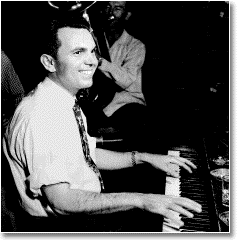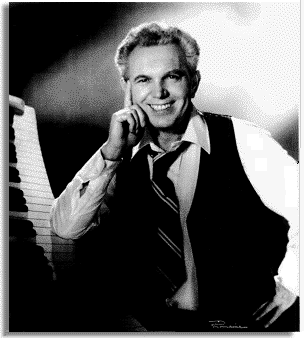 Wally Rose was one of three sons born to Janet Pecansu and Manuel Rodrigues
(The family changed its name to Rose before Wally's birth). He was born at home
in Oakland, California, October 2, 1913. His parents were of Portuguese descent
and natives of Hawaii, so the Rose family sailed to Honolulu many times during his
childhood. Rose attended the first through third grades in Honolulu before settling
with his family in San Francisco. His family's home was on the southwest corner
of 20th and Diamond Streets in the Eureka Valley, not far from the schools of Mission
Dolores and Most Holy Redeemer Church, which he also attended.
Wally Rose was one of three sons born to Janet Pecansu and Manuel Rodrigues
(The family changed its name to Rose before Wally's birth). He was born at home
in Oakland, California, October 2, 1913. His parents were of Portuguese descent
and natives of Hawaii, so the Rose family sailed to Honolulu many times during his
childhood. Rose attended the first through third grades in Honolulu before settling
with his family in San Francisco. His family's home was on the southwest corner
of 20th and Diamond Streets in the Eureka Valley, not far from the schools of Mission
Dolores and Most Holy Redeemer Church, which he also attended.
Mr. Rose always gave credit to his mother for the encouragement to learn the piano. After attending Oakland's Lockwood Junior High School, Rose attended Castlemont High School. He first studied piano with Miss Alice Eggers, a distinguished music teacher at Castlemont High School. In the 1930s piano studies were continued with Miss Elizabeth Simpson, who had studios in Berkeley and San Francisco. After graduation from Castlemont High School he played in dance bands aboard ships around the world in the early 1930s, including a sea- The Lu Watters Yerba Buena Jazz Band kindled the flame that sparked the popular American traditional jazz revival. The original band included Lu Watters (cornet, director), Bob Scobey (cornet), Turk Murphy (trombone), Ellis Horne (clarinet), Wally Rose (piano), Harry Mordecai (banjo), Russ Bennett (banjo-guitar), Dick Lammi (brass bass), Bill Dart (drums) and Clancy Hayes (banjo-vocal). Rose remained with Watters throughout the 1940s, except for three years' Navy service. After honorable discharge from the Navy he began teaching a few serious piano students, sometimes in collaboration with his own teacher, Miss Simpson. Rose played with Bob Scobey during 1950-51, Turk Murphy 1952-54, and spent many years as soloist in San Francisco. During his engagement at the Tin Angel he was the only person mentioned by name in Nat Farbman's Life magazine pictorial essay about San Francisco. For three years he appeared on the "This Morning Show" broadcast by KPIX-TV. Other San Francisco engagements were at the Sheraton- In 1973 the San Francisco Museum of Modern Art featured Wally Rose on its program "History of Jazz Piano." Similarly, he was part of the University of California's Extension program called "Five Jazz Pianists of The West." He has played at the Newport Jazz Festival [New York City, July 4, 1973], The Ragtime Festival in Sedalia (the cradle of Ragtime), Missouri, and the Saint Louis Ragtime Festival. He has been honored by the Bohemian Club and was a guest at Europe's famed annual Jazz Festival at Breda, Holland (May, 1978). In the 1970s and '80s he was Peter Mintun's substitute at L'Etoile and Masons Restaurant in San Francisco. As a Columbia and Good Time Jazz recording artist, Wally Rose made more records, over one hundred, than any other San Francisco pianist. In 1953, Rose recorded two very influential solo LPs: Ragtime Classics (Good Time Jazz, GTJL-3) and Ragtime Piano Masterpieces (Columbia CL 6260). Critics at Down Beat gave Ragtime Classics five stars, its highest rating.  He has given hundreds of concerts,
including two with Arthur Fiedler conducting the San Francisco Symphony Orchestra
[August 18, 1959]. In the concert field, he performed Beethoven's E-Flat Major (Emperor)
Concerto and works by Shostakovich, Debussy, Griffes and Scriabine. He has given hundreds of concerts,
including two with Arthur Fiedler conducting the San Francisco Symphony Orchestra
[August 18, 1959]. In the concert field, he performed Beethoven's E-Flat Major (Emperor)
Concerto and works by Shostakovich, Debussy, Griffes and Scriabine.
Mr. Rose always thought it was important for a person to leave his or her mark on the world in the form of instruction, so he taught piano students throughout his adult life. He taught a few qualified students, who included Peter Clute, who became Turk Murphy's pianist and business partner. Wally is also a life member of San Francisco Musicians' Union, Local 6, and former member of Bohemian Club. In an interview he said he had been inspired by some piano rolls found in a friend's attic. In numerous cases, Rose was the first pianist to ever record some of the long- Noted ragtime scholars and pianists Trebor Tichenor and Bob Wright believe the basis for Rose's style has its origins in the work of the pre-World War I pianists of America's Midwest. Rose made much use of the dotted- In They All Played Ragtime, by Rudi Blesh and Harriet Janis, the authors end the book by saying: [Ralph] Sutton and Wally Rose are the leaders of a whole new generation of white ragtimers who may succeed In making this music once more a field in which Negroes will find an artistic and economic foothold... Jackie Peterson in the San Francisco Chronicle wrote: "Authorities concede that Wally is one of the outstanding living exponents of genuine ragtime music." For approximately a decade, Wally was the only pianist anywhere that kept turn-of- Ragtime authority and pianist Max Morath said it was Wally Rose "...who pioneered the rediscovery of ragtime." In a 1956 letter to Nat Hentoff, Wally Rose epitomized many of his feelings about ragtime and revivalism: Why do I go back to the ragtime period? Mainly because I love all kinds of music and have an insatiable curiosity. I find a certain charm in the era. After all, I can look at ragtime objectively (You know it was highly controversial in its day, and was considered degrading to play). Evidently the situation hasn't improved much for now in 1956, I'm being criticized for playing it, although in a slightly different way. You must know that [in] the immediate years after Bach, his music tended to disappear from the scene, and I believe it was Mendelssohn who renewed interest in Bach's music. What am I trying to prove? Nothing, merely trying to share a neglected part of jazz music with as many people as I can. Ed Sprankle and Peter Mintun contributed to this article. Hear Wally Rose with Lu Watters from this 1950 KLX-AM, Oakland, aircheck Return to the top of the page. | ||||||||||||
| This site and contents ©1995-2014 The Museum of the City of San Francisco | ||||||||||||
